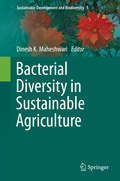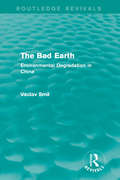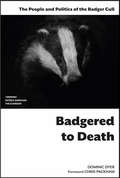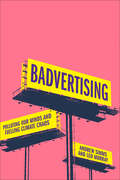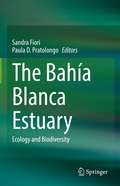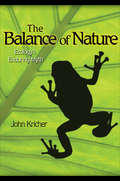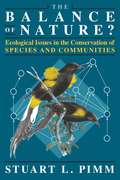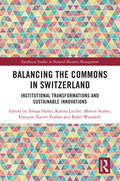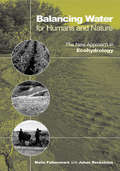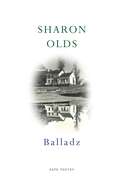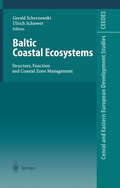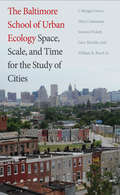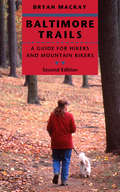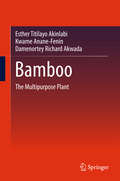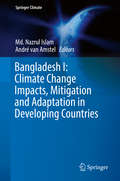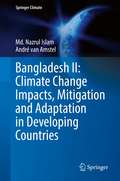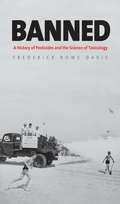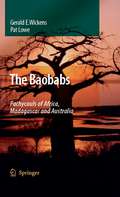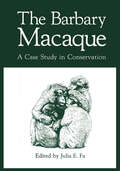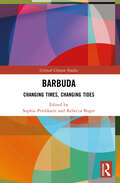- Table View
- List View
Bacterial Diversity in Sustainable Agriculture (Sustainable Development and Biodiversity #1)
by Dinesh K. MaheshwariThe earth’s biodiversity is a degree of ecosystem health which is vital to ecology and environmental sustainability. The microbial world is the largest unexplored reservoir. The agro-ecosystem enriched with rhizosphere implicit abundant and species-rich component of microbial diversity. Its global exploration designs a worldwide framework for agricultural sustainability adjoining benefits in its conservation.Agricultural sustainability requires a major share from ecosystem management which is better paid by microbial diversity and conservation. Diversity of bacteria influences plant productivity providing nutrient convenience from soil instead altering per se community and diversity in the rhizosphere where they may influence mechanistic competent and antagonistic micro-flora. The potential species among the diversity are therefore, essential subjective to their maintenance for use around the globe. Microbial population in agro-ecosystem is influenced by stresses, reduce functionality as a component. It is therefore, important to explore secrets of planned strategy so as to unravel the microbial diversity and conservation in agricultural development. Microorganisms are minute, pervasive in nature and alleged as disease host instead tiny recognize as employee of agro-ecosystem, indulge in agricultural development and potential contributor in world of ecological and economical wealth creation. This step pertinently would help to launch scientific motivation needed to support the refrain of microbial diversity and conservation.
The Bad Earth: Environmental Degradation in China (Routledge Revivals)
by Vaclav SmilAs China strives to significantly increase its economic output, the nation faces an acute deterioration of the physical resources from which this prodigious growth springs. Major problems include water shortages, the pollution of water, high levels of carcinogens in the air, accelerating erosion, and industrial pollution. Originally published in 1984, Vaclav Smil documents and evaluates China’s environmental crisis. This title will be of particular interest for students of Environmental Studies and Development Studies.
The Bad Earth: Environmental Degradation in China (Routledge Revivals)
by Vaclav SmilAs China strives to significantly increase its economic output, the nation faces an acute deterioration of the physical resources from which this prodigious growth springs. Major problems include water shortages, the pollution of water, high levels of carcinogens in the air, accelerating erosion, and industrial pollution. Originally published in 1984, Vaclav Smil documents and evaluates China’s environmental crisis. This title will be of particular interest for students of Environmental Studies and Development Studies.
Badgered to Death: The People and Politics of the Badger Cull
by Dominic Dyer'A thriller, whodunnit and impassioned polemic' (Patrick Barkham, Guardian) Dominic Dyer explores the science and electioneering behind Britain's most controversial wildlife policy: the badger cull. He exposes the catastrophic handling of bovine TB by the UK government, the political manoeuvring that led to the cull being devised in 2010, and the ongoing close relationship between its two instigators in Britain — the National Farmers Union and the Department of the Environment, Food and Rural Affairs (DEFRA). He shines an unflattering spotlight on Cabinet ministers, the veterinary profession, environmental NGOs and the BBC, accusing them of doing too little to protect a protected wild species. Introduction by Chris Packham, naturalist and BBC TV presenter 'For many reasons we had come to love the badger, to cherish and admire it, to protect and celebrate it and of course many still do. 'But the reputation of this essential member of the UK's ecology has been targeted by a smear campaign which has been swallowed by the gullible and fuelled by those with vested interests.' (Chris Packham, Introduction) REVIEWS 'A thriller, whodunnit and impassioned polemic, this is the inside story of the badger cull. 'A vital must-read for anyone concerned about the badger's enduring place in the British countryside.' (Patrick Barkham, nature writer for The Guardian.) It should be read by all those battling against government policies that put money ahead of science and the environment.Our natural world is too important to be over-ridden in this way. Dyer... pays tribute to the 'Badger Army', those many individuals from all walks of life who turned out to protest and importantly, once culling started, to protect the badgers out in the field. Badgered to Death is for them because it tells them just why they must keep fighting the culls. It will convince any reader how very wrong and ineffective the culls will prove to be. (Lesley Docksey, The Ecologist) I enjoyed reading this book and I strongly recommend it to you. If you sign up to the main message of the book, that these culls are a waste of money, a waste of Badgers and at best a partial and inefficient way to reduce bovine TB then you will be hopping mad right now and reading this book won't calm you down, it will energise you. (Mark Avery, MarkAvery.info) A vital read for anyone cares about the future of British wildlife
Badvertising: Polluting Our Minds and Fuelling Climate Chaos
by Andrew Simms Leo Murray‘Why do we allow adverts that actively promote our own destruction? Halting climate catastrophe is hard enough without ads selling things that pollute more. With Badvertising, Simms and Murray have done the world an urgent favour. Funny and readable, it will make us all see advertising in a very different way’ Dr Chris van Tulleken, doctor, broadcaster and author of Ultra-Processed People‘Hugely timely and important … Grapples with advertising’s role in enabling climate crimes – and sets out why and how we need to stop the industry’s complicity in its tracks, for the sake of a liveable future’ Caroline Lucas MP‘Simms and Murray are clear-headed guides. Learn the history, be enraged at the tactics, and join the struggle for a less polluted public sphere’ Sam Knights, writer, actor and activist‘A much-needed book whose time has come. The continued advertising of high-carbon products at a time of climate crisis is a form of insanity. The authors are absolutely right’ Bill McGuire, Professor Emeritus of Earth Sciences, University College London‘This book was a watershed moment for me. Since it can’t have an advertising campaign, we all need to tell our friends about it’ Jeremy Vine, broadcaster and journalistAdvertising is selling us a dream, a lifestyle. It promises us fulfilment and tells us where to buy it – from international flights to a vast array of goods we consume like there is no tomorrow. The truth is, if advertising succeeds in keeping us on our current trajectory, there may not be a tomorrow.In Badvertising, Andrew Simms and Leo Murray raise the alarm on an industry that is making us both unhealthy and unhappy, and that is driving the planet to the precipice of environmental collapse in the process.What is the psychological impact of being barraged by literally thousands of advertisements a day? How does the commercialisation of our public spaces weaken our sense of belonging? How are car manufacturers, airlines and oil companies lobbying to weaken climate action? Examining the devastating impact of advertising on our minds and on the planet, Badvertising also crucially explores what we can do to change things for the better.Andrew Simms was called a ‘master at joined-up progressive thinking’ by New Scientist magazine. He co-authored the original Green New Deal, came up with Earth Overshoot Day, and jointly proposed the Fossil Fuel Non- Proliferation Treaty. He is the author of several books including Ecological Debt, Tescopoly, Cancel the Apocalypse and Economics: A Crash Course. He co-directs the New Weather Institute, is Assistant Director of Scientists for Global Responsibility, coordinates the Rapid Transition Alliance and is a Research Fellow at the University of Sussex.Leo Murray co-founded climate action charity Possible, where he is currently Director of Innovation, as well as noughties direct action pressure group Plane Stupid and pioneering solar rail enterprise Riding Sunbeams. Murray is also the creator of the Frequent Flyer Levy and the brains behind the Trump Baby blimp which rose to global fame during Donald Trump’s US presidency.
The Bahía Blanca Estuary: Ecology and Biodiversity
by Sandra M. Fiori Paula D. PratolongoThe Bahía Blanca Estuary is one of the largest coastal systems in Atlantic South America. This mesotidal estuary, situated in a sharp transition between humid subtropical and semiarid climates, has a unique combination of large interannual climatic variations. The estuarine area encompasses roughly 2300 square kilometers and is composed of wide expanses of intertidal flats, salt marshes, and emerged islands, which create intricate landscape patterns. Natural environments in the estuary sustain a high concentration of marine and terrestrial species, including endemic, threatened, and endangered fish and shorebirds. Puerto Cuatreros, in the inner zone of the estuary, hosts a permanent marine research station, whose records span more than 30 years of biophysical variables, and represent one of the largest time series of ecological data in South America. Beyond its ecological relevance, the Bahía Blanca Estuary is under increasing anthropogenic pressure from large urban settlements, industrial developments and harbors, raising the question of how to balance conservation and development. The Bahía Blanca Estuary: Ecology and Biodiversity offers a comprehensive review of life in the ecosystems of the estuary. The book is divided into five major sections, the first of which provides a description of the regional setting and covers key aspects of estuarine dynamics. The three following sections are dedicated to different habitat types and, within each section, the chapters are organized around major functional groups from pelagic and benthic environments. The fifth and final section covers issues related to management and conservation. Overall, the book provides essential and up-to-date reference material on the biodiversity and ecosystem processes of the Bahía Blanca Estuary, and will appeal to a broad international audience.
The Balance of Nature: Ecology's Enduring Myth
by John KricherThe idea of a balance of nature has been a dominant part of Western philosophy since before Aristotle, and it persists in the public imagination and even among some ecologists today. In this lively and thought-provoking book, John Kricher demonstrates that nature in fact is not in balance, nor has it ever been at any stage in Earth's history. He explains how and why this notion of a natural world in balance has endured for so long, and he shows why, in these times of extraordinary human influence on the planet's ecosystems, it is critical that we accept and understand that evolution is a fact of life, and that ecology is far more dynamic than we ever imagined. The Balance of Nature traces the fascinating history of the science of ecology and evolutionary biology, from the discipline's early innovators to the advent of Darwin and evolution, to the brilliant and inquisitive scientific minds of today. Blending insights and entertaining stories from his own remarkable life in science, Kricher reveals how evolution is a powerful engine that drives ecological change, how nature is constantly in flux and, in effect, quite naturally out of balance--and how notions to the contrary are misguided and ultimately hazardous to us all. The Balance of Nature forcefully argues that an understanding of the dynamic nature of ecology and evolution is essential to formulating policies of environmental ethics to guide humanity toward a more responsible stewardship of our planet's ecosystems.
The Balance of Nature: Ecology's Enduring Myth
by John C. KricherThe idea of a balance of nature has been a dominant part of Western philosophy since before Aristotle, and it persists in the public imagination and even among some ecologists today. In this lively and thought-provoking book, John Kricher demonstrates that nature in fact is not in balance, nor has it ever been at any stage in Earth's history. He explains how and why this notion of a natural world in balance has endured for so long, and he shows why, in these times of extraordinary human influence on the planet's ecosystems, it is critical that we accept and understand that evolution is a fact of life, and that ecology is far more dynamic than we ever imagined. The Balance of Nature traces the fascinating history of the science of ecology and evolutionary biology, from the discipline's early innovators to the advent of Darwin and evolution, to the brilliant and inquisitive scientific minds of today. Blending insights and entertaining stories from his own remarkable life in science, Kricher reveals how evolution is a powerful engine that drives ecological change, how nature is constantly in flux and, in effect, quite naturally out of balance--and how notions to the contrary are misguided and ultimately hazardous to us all. The Balance of Nature forcefully argues that an understanding of the dynamic nature of ecology and evolution is essential to formulating policies of environmental ethics to guide humanity toward a more responsible stewardship of our planet's ecosystems.
The Balance of Nature: Ecology's Enduring Myth
by John C. KricherThe idea of a balance of nature has been a dominant part of Western philosophy since before Aristotle, and it persists in the public imagination and even among some ecologists today. In this lively and thought-provoking book, John Kricher demonstrates that nature in fact is not in balance, nor has it ever been at any stage in Earth's history. He explains how and why this notion of a natural world in balance has endured for so long, and he shows why, in these times of extraordinary human influence on the planet's ecosystems, it is critical that we accept and understand that evolution is a fact of life, and that ecology is far more dynamic than we ever imagined. The Balance of Nature traces the fascinating history of the science of ecology and evolutionary biology, from the discipline's early innovators to the advent of Darwin and evolution, to the brilliant and inquisitive scientific minds of today. Blending insights and entertaining stories from his own remarkable life in science, Kricher reveals how evolution is a powerful engine that drives ecological change, how nature is constantly in flux and, in effect, quite naturally out of balance--and how notions to the contrary are misguided and ultimately hazardous to us all. The Balance of Nature forcefully argues that an understanding of the dynamic nature of ecology and evolution is essential to formulating policies of environmental ethics to guide humanity toward a more responsible stewardship of our planet's ecosystems.
The Balance of Nature?: Ecological Issues in the Conservation of Species and Communities
by Stuart L. PimmEcologists, although they acknowledge the problems involved, generally conduct their research on too few species, in too small an area, over too short a period of time. In The Balance of Nature?, a work sure to stir controversy, the distinguished theoretical ecologist Stuart L. Pimm argues that ecology therefore fails in many ways to address the enormous ecological problems now facing our planet. Ecologists describing phenomena on larger scales often use terms like "stability," "balance of nature," and "fragility," and Pimm begins by considering the various specific meanings of these terms. He addresses five kinds of ecological stability—stability in the strict sense, resilience, variability, persistence, and resistance—and shows how they provide ways of comparing natural populations and communities as well as theories about them. Each type of stability depends on characteristics of the species studied and also on the structure of the food web in which the species is embedded and the physical features of the environment. The Balance of Nature? provides theoretical ecology with a rich array of questions—questions that also underpin pressing problems in practical conservation biology. Pimm calls for nothing less than new approaches to ecology and a new alliance between theoretical and empirical studies.
Balancing the Commons in Switzerland: Institutional Transformations and Sustainable Innovations (Earthscan Studies in Natural Resource Management)
by Tobias Haller Karina Liechti Martin Stuber François-Xavier Viallon Rahel WunderliBalancing the Commons in Switzerland outlines continuity and change in the management of common-pool resources such as pastures and forests in Switzerland. The book focusses on the differences and similarities between local institutions (rules and regulations) and forms of commoners’ organisations (civic communities and corporations) which have managed common property for several centuries and have shaped the cultural landscapes of Switzerland. At the core of the book are five case studies from the German, French and Italian speaking regions of Switzerland. Beginning in the late medieval ages and focussing on the transformative periods in the 19th and 20th Century, it traces the internal and external political, economic and societal changes and examines what impact these changes had on commoners. It goes beyond the work of Robert Netting and Elinor Ostrom, who discussed Swiss commons as a unique case of robustness, by analysing how local commoners reacted to, but also shaped changes by adapting and transforming common property institutions. Thus, the volume highlights how institutional changes in the management of the commons on the local level are embedded in the public policies of the respective cantons, and the state, which generates a high heterogeneity and an actual laboratory situation. It shows the very different ways that local collective organisations and their members have followed in order to cope with the loss of value of the commons and the increased workload for maintaining common property management. Providing insightful case studies of commons management, this volume delivers theoretical contributions and lessons to be learned for the commons worldwide. This book will be of great interest to students and scholars of the commons, natural resource management and agricultural development.
Balancing the Commons in Switzerland: Institutional Transformations and Sustainable Innovations (Earthscan Studies in Natural Resource Management)
by Tobias Haller, Karina Liechti, Martin Stuber, François-Xavier Viallon and Rahel WunderliBalancing the Commons in Switzerland outlines continuity and change in the management of common-pool resources such as pastures and forests in Switzerland. The book focusses on the differences and similarities between local institutions (rules and regulations) and forms of commoners’ organisations (civic communities and corporations) which have managed common property for several centuries and have shaped the cultural landscapes of Switzerland. At the core of the book are five case studies from the German, French and Italian speaking regions of Switzerland. Beginning in the late medieval ages and focussing on the transformative periods in the 19th and 20th Century, it traces the internal and external political, economic and societal changes and examines what impact these changes had on commoners. It goes beyond the work of Robert Netting and Elinor Ostrom, who discussed Swiss commons as a unique case of robustness, by analysing how local commoners reacted to, but also shaped changes by adapting and transforming common property institutions. Thus, the volume highlights how institutional changes in the management of the commons on the local level are embedded in the public policies of the respective cantons, and the state, which generates a high heterogeneity and an actual laboratory situation. It shows the very different ways that local collective organisations and their members have followed in order to cope with the loss of value of the commons and the increased workload for maintaining common property management. Providing insightful case studies of commons management, this volume delivers theoretical contributions and lessons to be learned for the commons worldwide. This book will be of great interest to students and scholars of the commons, natural resource management and agricultural development.
Balancing Water for Humans and Nature: The New Approach in Ecohydrology
by Johan RockstromBalancing Water for Humans and Nature, authored by two of the world's leading experts on water management, examines water flows - the 'blood stream' of both nature and society - in terms of the crucial links, balances, conflicts and trade-offs between human and environmental needs. The authors argue that a sustainable future depends fundamentally on our ability to manage these trade-offs and encourage long-term resilience. They advocate an ecohydrological approach to land/water/environmental problems and advance a strong, reasoned argument for viewing precipitation as the gross fresh water resource, ultimately responsible for sustaining all terrestrial and aquatic ecosystem services. This book makes the most coherent and holistic argument to date for a new ecological approach to understanding and managing water resources for the benefit of all. Basing their analysis on per capita needs for an acceptable nutritional diet, the authors analyse predictions of the amounts of water needed for global food production by 2050 and identify potential sources. Drawing on small-scale experiences in Africa and Asia, they also cover the vulnerability of the semi-arid tropics through a simplified model of green and blue water scarcity components.
Balancing Water for Humans and Nature: The New Approach in Ecohydrology
by Johan RockstromBalancing Water for Humans and Nature, authored by two of the world's leading experts on water management, examines water flows - the 'blood stream' of both nature and society - in terms of the crucial links, balances, conflicts and trade-offs between human and environmental needs. The authors argue that a sustainable future depends fundamentally on our ability to manage these trade-offs and encourage long-term resilience. They advocate an ecohydrological approach to land/water/environmental problems and advance a strong, reasoned argument for viewing precipitation as the gross fresh water resource, ultimately responsible for sustaining all terrestrial and aquatic ecosystem services. This book makes the most coherent and holistic argument to date for a new ecological approach to understanding and managing water resources for the benefit of all. Basing their analysis on per capita needs for an acceptable nutritional diet, the authors analyse predictions of the amounts of water needed for global food production by 2050 and identify potential sources. Drawing on small-scale experiences in Africa and Asia, they also cover the vulnerability of the semi-arid tropics through a simplified model of green and blue water scarcity components.
Balladz: ‘The most accessible poet of her generation’ Telegraph
by Sharon OldsArguably America's greatest living poet, Sharon Olds enters her eightieth year with a book for our times: a book of fear, fragility and love of life'At the time of have-not, I look at myself in this mirror,' writes Olds in this self-scouring, exhilarating collection, which opens with a section of quarantine poems, followed by her 'Amherst Balladz', honouring Emily Dickinson - 'she was our Girl - our Woman - / Man enough - for me' - and leads to celebrations of lost friends and lovers: her childhood, young womanhood, and old age all mixed up together. She examines her white privilege, sees her mother 'flushed and exalted at punishment time', celebrates the human body, even in ageing, and looks with wonder at the natural world and how we've spoiled it.Renowned for her poetry of searing honesty, sexual frankness and brave originality, Sharon Olds' new book emerges 'at the eleventh hour of the end of the world', from the time of plague, this time of loss, where she can look at the world and her life and tell us plainly 'love is the love of who we are, it is a form of knowing.'
Baltic Coastal Ecosystems: Structure, Function and Coastal Zone Management (Central and Eastern European Development Studies (CEEDES))
by Gerald Schernewski, Ulrich SchiewerBetween November 20 and 23, 2000, the workshop "Baltic Coastal Ecosystems - Structure, Function and Coastal Zone Management" took place in Rostock, Ger many. The workshop was organised by the Institute of Aquatic Ecology of the University of Rostock and the Baltic Sea Research Institute Warnemiinde on be half of the Wissenschafts-Verbund Umwelt (WVU) at the University of Rostock. It was the third trans-disciplinary event that tried to link ecological and socio economical aspects with respect to the Baltic Sea. The first symposium was held in 1992, entitled "The Future of the Baltic Sea - Ecology, Economics, Administra tion and Teaching", and the second event took place in 1996, entitled "Sustainable Development in Coastal Regions - a Comparison Between North Atlantic Coast and Baltic Sea". The workshop "Baltic Coastal Ecosystems - Structure, Function and Coastal Zone Management" tried to provide an interdisciplinary forum for discussions, the exchange of ideas and the presentation of scientific results with respect to the Bal tic coast.
The Baltimore School of Urban Ecology: Space, Scale, and Time for the Study of Cities
by J. Morgan Grove Mary Cadenasso Steward T. Pickett Gary E. Machlis William R. BurchThe first “urban century” in history has arrived: a majority of the world’s population now resides in cities and their surrounding suburbs. Urban expansion marches on, and the planning and design of future cities requires attention to such diverse issues as human migration, public health, economic restructuring, water supply, climate and sea-level change, and much more. This important book draws on two decades of pioneering social and ecological studies in Baltimore to propose a new way to think about cities and their social, political, and ecological complexity that will apply in many different parts of the world. Readers will gain fresh perspectives on how to study, build, and manage cities in innovative and sustainable ways.
Baltimore Trails: A Guide for Hikers and Mountain Bikers
by Bryan MacKayBaltimore Trails is a comprehensive and detailed guide to trails on public lands in and around Baltimore. Discover Hemlock Gorge, a small slice of Appalachia transported into northern Baltimore County, with its timeless peace and ancient gnarled hemlocks; or Black Marsh, where birds skulk among the vegetation of pristine freshwater wetlands; or the unique landscape of Soldiers Delight Natural Environment Area, which shelters more than 38 rare plant species. Baltimore Trails answers the needs of hikers and mountain bikers, offering accurate maps, up-to-date access information, and reliable trail descriptions.Bryan MacKay, a lifelong Baltimore resident and avid naturalist, walked, cycled, and explored nearly 80 trails in local state, county, and city parks, as well as area watersheds. He provides a detailed description, topographic map, and the length, location, and degree of difficulty for each trail. Some trails offer an easy afternoon stroll, while others provide a day of rugged hiking or biking. Thumbnail essays offer scenic highlights and discuss typical plants, animals, and local ecology.Every trail was field-checked in 2007 for the second edition. Miles of new trails are included, as is updated information on recent trail reroutes.
Bamboo: The Multipurpose Plant
by Esther Titilayo Akinlabi Kwame Anane-Fenin Damenortey Richard AkwadaThis book is intended for use both in the industry and the academia. It introduces the physical, chemical and the mechanical properties as well as the characterization of bamboo. Novel industrial applications in structural, non-structural, reinforcement, afforestation, land reclamation, environmental significance, textile, medical, geotechnical, hydraulic, food, pulp and the paper industries are addressed in detail.Bamboo has been used for centuries as a structural material as well as in diverse engineering applications, food and medicinal purposes, especially in Asia. As a natural fiber composite, bamboo has the potential for many developments in academic and industrial research. Current literature on composites tends to focus on bamboo as a plant or solely as a structural engineering material. This book seeks to bring together these two extremes and provides a holistic resource on the subject.
Bangladesh I: Climate Change Impacts, Mitigation and Adaptation in Developing Countries (Springer Climate)
by André Van Amstel Md. Nazrul IslamThe aim of this book is to provide information to scientists and local government to help them better understand the particularities of the local climate. Climate change is one of the biggest challenges to society. It can lead to serious impacts on production, life and environment on a global scale. Higher temperatures and sea level rise will cause flooding and water salinity problems which bring about negative effects on agriculture and high risks to industry and socio-economic systems in the future. Climate change leads to many changes in global development and security, especially energy, water, food, society, job, diplomacy, culture, economy and trade. The Intergovernmental Panel on Climate Change (IPCC) defines climate change as: “Any change in climate over time, whether due to natural variability or as a result of human activity.” Global climate change has emerged as a key issue in both political and economic arenas. It is an increasingly questioned phenomenon, and progressive national governments around the world have started taking action to respond to these environmental concerns.
Bangladesh II: Climate Change Impacts, Mitigation and Adaptation in Developing Countries (Springer Climate)
by Md. Nazrul Islam André van AmstelThis volume aims to develop a framework for disaster and climate risk resilient livelihood system in Bangladesh using a policy oriented approach. It highlights the possible impacts of climate change on groundwater based irrigation in the country. Climate change is one of biggest challenges to society. It can lead to serious impacts on production, life and environment on a global scale. Higher temperatures and sea level rise will cause flooding and water salinity problems which will bring about negative effects on agriculture and high risks to industry and socio-economic systems in the future. Climate change will lead to many changes in global development and security especially energy, water, food, society, job, diplomacy, culture, economy and trade. The Intergovernmental Panel on Climate Change (IPCC) defines climate change as: “Any change in climate over time, whether due to natural variability or as a result of human activity.” Global climate change has emerged as a key issue in both political and economic arenas. It is an increasingly questioned phenomenon, and progressive national governments around the world have started taking action to respond to these environmental concerns.
Banned: A History of Pesticides and the Science of Toxicology
by Frederick Rowe DavisRachel Carson’s eloquent book Silent Spring stands as one of the most important books of the twentieth century and inspired important and long-lasting changes in environmental science and government policy. Frederick Rowe Davis thoughtfully sets Carson’s study in the context of the twentieth century, reconsiders her achievement, and analyzes its legacy in light of toxic chemical use and regulation today. Davis examines the history of pesticide development alongside the evolution of the science of toxicology and tracks legislation governing exposure to chemicals across the twentieth century. He affirms the brilliance of Carson’s careful scientific interpretations drawing on data from university and government toxicologists. Although Silent Spring instigated legislation that successfully terminated DDT use, other warnings were ignored. Ironically, we replaced one poison with even more toxic ones. Davis concludes that we urgently need new thinking about how we evaluate and regulate pesticides in accounting for their ecological and human toll.
The Baobabs: Pachycauls of Africa, Madagascar and Australia
by G.E. WickensThis is the only comprehensive account of all eight species in the genus Adansonia. It describes the historical background from the late Roman period to the present. It covers the extraordinary variety of economic uses of baobabs. There are also appendices on vernacular names, gazetteer, economics, nutrition and forest mensuration. This book fills a gap in the botanical literature. It deals with a genus that has fascinated and intrigued scientists and lay persons for centuries.
The Barbary Macaque: A Case Study in Conservation (Contributions To Primatology Ser. #Vol. 23)
by John E. FaThe Barbary macaque (all too often mistakenly called an ape) was first brought to the attention of the Conservation Working Party of the Primate Society of Great Britain late 1979 when John Fa reported that 'surplus' animals were being sent from Gibraltar to dubious locations, such as an Italian safari park. Since there had been no scientific input into the Army's management of the monkey colony on Gibraltar, and there was concern about inbreeding, nutrition and health - about the long-term viability of the colony, it was felt that the Society could help. The Gibraltar Scientific Authority and the Army were very receptive to our offer and ideas, and this topic occupied successive chairmen over the last few years - Robin Dunbar and Richard Wrangham, myself and now Miranda Stevenson - with constant prompting and help from John Fa. Considerations soon extended to the status of the species as a whole, so that there have been three main aspects:- (1) the improved health of a larger self-sustaining population on Gibraltar, (2) the status and behavioural biology of natural populations in North Africa (Morocco and Algeria), and (3) the breeding achievements in European parks and zoos, and their potential for reintroduction to suitable areas in North Africa, along with other possibilities. Robin Dunbar organized the compilation of recommendations for managing the Gibraltar colony with regard to numbers, age-sex struc ture and behavioural relationships, with some observations on diet to avoid obesity and infertility.
Barbuda: Changing Times, Changing Tides (Critical Climate Studies)
by Sophia Perdikaris Rebecca BogerThis volume explores a range of themes including impacts of climate change, resilience, sustainability, indigeneity, cultural genocide, disaster capitalism, preservation of biodiversity, and environmental degradation. Focusing on the island of Barbuda in the West Indies, it shares critical insights into how climate change is reshaping our world. The book examines how climate has changed in the Caribbean over different spatial and temporal scales and how varying natural and anthropogenic factors have shaped Barbuda’s climatic and cultural history. It highlights projections of 21st-century climate change for the Caribbean region and its likely impacts on Barbuda’s coastal ecosystems, potable groundwater resources, and heritage. With essays by researchers from the United States, Canada, Caribbean, and Europe, this volume straddles a range of disciplines such as archaeology, anthropology, paleoclimatology, environmental sciences, science education, and Traditional Ecological Knowledge (TEK). Drawing on interdisciplinary and transdisciplinary approaches that explore the intersection of natural and social systems over the longue durée, the volume will be of interest to scholars, researchers, and students of ethnography, social anthropology, climate action, development studies, public policy, and climate change.
